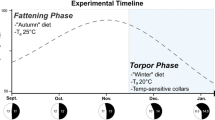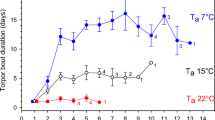Summary
Three subspecies ofPeromyscus inhabiting the montane, foothill, and coastal plain regions of the Carolinas were trapped in midwinter and the occurrence of spontaneous and ration-induced daily torpor was monitored via biotelemetric determination of body temperature. All tests were undertaken with field-caught mice that were subjected to a minimum of laboratory acclimation (two days). The tendency to enter torpor in the presence of adequate food was highest inP. maniculatus nubiterrae, whose natural montane habitat presents it with the greatest seasonal stress in terms of ambient temperature and food availability. This species exhibited significantly (P<0.05) longer spontaneous torpor bouts than did the two lowland subspecies,P. gossypinus gossypinus andP. leucopus leucopus (Table 1). Restriction of food to one-half thead libitum level increased the frequency, duration, and depth (mean minimum body temperature) of torpor in all three species (Fig. 1).P. maniculatus, however, displayed significantly (P<0.001) longer episodes of torpor induced by rationing than did either of the other two subspecies. The ability to compensate for a reduction in energy intake by adjusting levels of energy utilization may profoundly affect survival during short-term environmental stress in any of these three species.
Similar content being viewed by others
References
Fuller WA, Stebbins LL, Dyke GR (1969) Overwintering of small mammals near Great Slave Lake, northern Canada. Arctic 22:34–55
Gaertner RA, Hart JS, Roy OZ (1973) Seasonal spontaneous torpor in the white-footed mouse,Peromyscus leucopus. Comp Biochem Physiol 45A:169–181
Hill RW (1975) Daily torpor inPeromyscus leucopus on an adequate diet. Comp Biochem Physiol 55A:413–423
Howard WE (1951) Relation between low temperature and available food to survival of small rodents. J Mamm 32:300–312
Hudson JW (1965) Temperature regulation and torpidity in the pygmy mouseBaiomys taylori. Physiol Zool 38:243–254
Hudson JW (1978) Shallow daily torpor: A thermoregulatory adaptation. In: Wang LCH, Hudson JW (eds) Strategies in cold; natural torpidity and thermogenesis. Academic Press, New York, pp 67–108
Lynch GR, Vogt FD, Smith HR (1978a) Seasonal study of spontaneous daily torpor in the white-footed mouse,Peromyscus leucopus. Physiol Zool 51:389–401
Lynch GR, White SE, Grundel R, Berger MS (1978b) Effects of photoperiod, melatonin administration, and thyroid block on spontaneous daily torpor and temperature regulation in the white-footed mouse,Peromyscus leucopus. J Comp Physiol 125:157–163
Mason EB (1974) Metabolic responses of two species ofPeromyscus raised in different thermal environments. Physiol Zool 47:68–74
Morhardt JE (1970) Body temperatures of white-footed mice (Peromyscus sp.) during daily torpor. Comp Biochem Physiol 33:423–439
National Oceanic and Atmospheric Administration (1973) Climatography of the United States No. 81 (By State). Monthly Normals of temperature, precipitation, and heating and cooling degree days. 1941–1970. US Department of Commerce.
Pivorun EB (1976) A biotelemetry study of the thermoregulatory patterns ofTamias striatus andEutamias minimus during hibernation. Comp Biochem Physiol 53A:265–271
Sealander JA, Jr (1951) Survival ofPeromyscus in relation to environmental temperature and acclimation at high and low temperatures. Am Midl Nat 46:257–311
Tucker VA (1966) Diurnal torpor and its relation to food consumption and weight changes in the California pocket mouse,Perognathus californicus. Ecology 47:245–252
Vogt FD, Lynch GR (1982) Influence of ambient temperature, nest availability, huddling, and daily torpor on energy expenditure in the white-footed mousePeromyscus leucopus. Physiol Zool 55:56–63
Wolff JO, Bateman GC (1978) Effects of food availability and ambient temperature on torpor cycles ofPerognathus flavus (Heteromyidae). J Mamm 59:707–716
Author information
Authors and Affiliations
Rights and permissions
About this article
Cite this article
Tannenbaum, M.G., Pivorun, E.B. Differences in daily torpor patterns among three southeastern species ofPeromyscus . J Comp Physiol B 154, 233–236 (1984). https://doi.org/10.1007/BF02464401
Accepted:
Issue Date:
DOI: https://doi.org/10.1007/BF02464401




